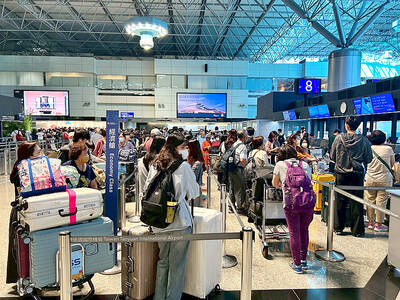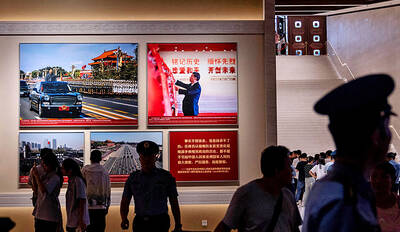Severe shaking while riding a roller-coaster might damage the alveolar wall in the lungs, causing pain in the throat, shoulder, neck and chest, physicians said.
Yuan’s General Hospital Department of Pediatrics doctor Yang Tai-jing (楊岱璟) cited the case of a 17-year-old student who in January came to the hospital complaining of pain in his throat, shoulders, neck and chest.
The patient said he thought it was a cold, Yang said, adding that an X-ray showed that the patient developed subcutaneous emphysema, or trapped air in tissue under the skin, in the shoulder and neck area, with parts of the chest affected and air building up in his chest cavity.
The patient had no external injuries, did not smoke and was not coughing.
The injuries sustained while riding a roller-coaster caused air to escape into the mediastinal cavity and into the tissue under the shoulder and neck, leading to subcutaneous emphysema and pneumomediastinum, Yang said.
Yang said the mediastinal cavity is between the lungs and contains organs such as the heart and the esophagus, adding that under normal conditions, organs should only receive oxygen breathed in through the esophagus and the trachea.
As the patient saw doctors on the third day after developing symptoms, his condition was mild enough to be treated with painkillers, Yang said.
If people feel unwell after strenuous exercise, strong bouts of coughing or after a holiday and have pain in the throat, chest, shoulder or neck, they should visit a doctor as soon as possible, Yang said.

Three batches of banana sauce imported from the Philippines were intercepted at the border after they were found to contain the banned industrial dye Orange G, the Food and Drug Administration (FDA) said yesterday. From today through Sept. 2 next year, all seasoning sauces from the Philippines are to be subject to the FDA’s strictest border inspection, meaning 100 percent testing for illegal dyes before entry is allowed, it said in a statement. Orange G is an industrial coloring agent that is not permitted for food use in Taiwan or internationally, said Cheng Wei-chih (鄭維智), head of the FDA’s Northern Center for

The Chinese military has built landing bridge ships designed to expand its amphibious options for a potential assault on Taiwan, but their combat effectiveness is limited due to their high vulnerability, a defense expert said in an analysis published on Monday. Shen Ming-shih (沈明室), a research fellow at the Institute for National Defense and Security Research, said that the deployment of such vessels as part of the Chinese People’s Liberation Army (PLA) Navy’s East Sea Fleet signals a strong focus on Taiwan. However, the ships are highly vulnerable to precision strikes, which means they could be destroyed before they achieve their intended

About 4.2 million tourist arrivals were recorded in the first half of this year, a 10 percent increase from the same period last year, the Tourism Administration said yesterday. The growth continues to be consistent, with the fourth quarter of this year expected to be the peak in Taiwan, the agency said, adding that it plans to promote Taiwan overseas via partnerships and major events. From January to June, 9.14 million international departures were recorded from Taiwan, an 11 percent increase from the same period last year, with 3.3 million headed for Japan, 1.52 million for China and 832,962 to South Korea,

REWRITING HISTORY: China has been advocating a ‘correct’ interpretation of the victory over Japan that brings the CCP’s contributions to the forefront, an expert said An elderly Chinese war veteran’s shin still bears the mark of a bullet wound he sustained when fighting the Japanese as a teenager, a year before the end of World War II. Eighty years on, Li Jinshui’s scar remains as testimony to the bravery of Chinese troops in a conflict that killed millions of their people. However, the story behind China’s overthrow of the brutal Japanese occupation is deeply contested. Historians broadly agree that credit for victory lies primarily with the Chinese Nationalist Party (KMT)-led Republic of China (ROC) Army. Its leader, Chiang Kai-shek (蔣介石), fled to Taiwan in 1949 after losing a